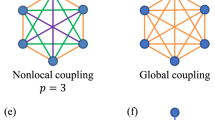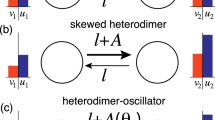Abstract
Various regimes of a ring of non-identical attention deficit disorder (ADD) models are studied in this paper. The ADD model used in this paper can show multistability. The dynamics of the coupled maps are investigated by changing the coupling strength and parameter mismatch. In this study, a similarity function is used for the lag synchronization analysis of the coupled maps. To explore the dynamics, state space, bifurcation diagram, and largest Lyapunov exponent are analyzed. By investigating the control parameters of the map, different bifurcations, including a transition from periodic dynamics to quasiperiodic and chaotic behavior, transition from chaotic to periodic and periodic to chaotic attractors are observed. The results show exciting dynamics in the ring of non-identical ADD maps. However, proper lag synchronization is not observed in the chaotic regions; the periodic and quasiperiodic areas demonstrate an appealing lag synchronization. Furthermore, the ring of non-identical ADD maps can illustrate multistability similar to the uncoupled ADD model.


















Similar content being viewed by others
Data availability
Data generated during the current study will be made available upon reasonable request.
References
J. Ma, J. Tang, A review for dynamics in neuron and neuronal network. Nonlinear Dyn. 89, 1569–1578 (2017)
L. Khaleghi et al., Chimera states in a ring of map-based neurons. Physica A 536, 122596 (2019)
B. Ibarz, J.M. Casado, M.A. Sanjuán, Map-based models in neuronal dynamics. Phys. Rep. 501(1–2), 1–74 (2011)
Y. Liu et al., Detecting bifurcation points in a memristive neuron model. Euro. Phys. J. Spec. Topics 228, 1943–1950 (2019)
M. Mehrabbeik et al., Synchronization and chimera states in the network of electrochemically coupled memristive Rulkov neuron maps. Math. Biosci. Eng. 18(6), 9394–9409 (2021)
I.A. Bashkirtseva, L.B. Ryashko, A.N. Pisarchik, Ring of map-based neural oscillators: From order to chaos and back. Chaos Solitons Fractals 136, 109830 (2020)
H. Cao, M.A. Sanjuan, A mechanism for elliptic-like bursting and synchronization of bursts in a map-based neuron network. Cogn. Process. 10(Suppl 1), S23-31 (2009)
N.F. Rulkov, Regularization of synchronized chaotic bursts. Phys. Rev. Lett. 86(1), 183–186 (2001)
N.F. Rulkov, Modeling of spiking-bursting neural behavior using two-dimensional map. Phys. Rev. E Stat. Nonlin. Soft Matter Phys. 65(4 Pt 1), 041922 (2002)
Courbage, M., V. Nekorkin, and L. Vdovin, Chaotic oscillations in a map-based model of neural activity. Chaos: An Interdisciplinary Journal of Nonlinear Science, 2007. 17(4): p. 043109.
D.R. Chialvo, Generic excitable dynamics on a two-dimensional map. Chaos Solitons Fractals 5(3–4), 461–479 (1995)
K. Aihara, T. Takabe, M. Toyoda, Chaotic neural networks. Phys. Lett. A 144(6–7), 333–340 (1990)
H. Tanaka, T. Ushio, S. Kawanami, A high-dimensional chaotic discrete-time neuron model and bursting phenomena. Phys. Lett. A 308(1), 41–46 (2003)
E.M. Izhikevich, F. Hoppensteadt, Classification of bursting mappings. Int. J. Bifurcation Chaos 14(11), 3847–3854 (2004)
J. Nagumo, S. Sato, On a response characteristic of a mathematical neuron model. Kybernetik 10(3), 155–164 (1972)
G. Baghdadi et al., A chaotic model of sustaining attention problem in attention deficit disorder. Commun. Nonlinear Sci. Numer. Simul. 20(1), 174–185 (2015)
B. Ibarz, H. Cao, M.A. Sanjuan, Bursting regimes in map-based neuron models coupled through fast threshold modulation. Phys. Rev. E Stat. Nonlin. Soft Matter Phys. 77(5 Pt 1), 051918 (2008)
N.N. Moghadam et al., How can the networks with various topologies change the occurrence of bifurcation points in a period-doubling route to chaos: a case study of neural networks in the presence and absence of disturbance. Euro. Phys. J. Plus 138(4), 362 (2023)
Boccaletti, S., et al., Synchronization: from coupled systems to complex networks. 2018: Cambridge University Press.
Moehlis, J., Dynamical Systems in Neuroscience: The geometry of excitability and bursting. 2008, JSTOR.
P.J. Uhlhaas, W. Singer, Neural synchrony in brain disorders: relevance for cognitive dysfunctions and pathophysiology. Neuron 52(1), 155–168 (2006)
T. Wang et al., Distinct changes in global brain synchronization in early-onset vs. Late-Onset Parkinson Disease. Front Aging Neurosci 12, 604995 (2020)
C. Hammond, H. Bergman, P. Brown, Pathological synchronization in Parkinson’s disease: networks, models and treatments. Trends Neurosci. 30(7), 357–364 (2007)
D. Hu, H. Cao, Stability and synchronization of coupled Rulkov map-based neurons with chemical synapses. Commun. Nonlinear Sci. Numer. Simul. 35, 105–122 (2016)
M. Courbage, O. Maslennikov, V. Nekorkin, Synchronization in time-discrete model of two electrically coupled spike-bursting neurons. Chaos Solitons Fractals 45(5), 645–659 (2012)
S. Li, Y. He, H. Cao, Necessary conditions for complete synchronization of a coupled chaotic Aihara neuron network with electrical synapses. Int J Bifurcation Chaos 29(05), 1950063 (2019)
I. Bashkirtseva, L. Ryashko, A.N. Pisarchik, Stochastic transitions between in-phase and anti-phase synchronization in coupled map-based neural oscillators. Commun. Nonlinear Sci. Numer. Simul. 95, 105611 (2021)
A. Ouannas et al., On the dynamics, control and synchronization of fractional-order Ikeda map. Chaos Solitons Fractals 123, 108–115 (2019)
S. Rakshit et al., Synchronization and firing patterns of coupled Rulkov neuronal map. Nonlinear Dyn. 94, 785–805 (2018)
A. Arenas et al., Synchronization in complex networks. Phys. Rep. 469(3), 93–153 (2008)
A. Pisarchik, I. Bashkirtseva, L. Ryashko, Noise-induced quasiperiodicity in a ring of unidirectionally-coupled nonidentical maps. Phys. Lett. A 383(14), 1571–1577 (2019)
N. Sasano, K. Saeki, Y. Sekine, Short-term memory circuit using hardware ring neural networks. Artificial Life and Robotics 9, 81–85 (2005)
O.L. Rourke, D.A. Butts, Cortical computations via transient attractors. PLoS ONE 12(12), e0188562 (2017)
A. Sajedin et al., Cholinergic modulation promotes attentional modulation in primary visual cortex-a modeling study. Sci. Rep. 9(20186), 2019 (2019)
Majhi, S., S. Rakshit, and D. Ghosh, Oscillation suppression and chimera states in time-varying networks. Chaos: An Interdisciplinary Journal of Nonlinear Science, 2022. 32(4).
S. Rakshit et al., Neuronal synchronization in long-range time-varying networks. Chaos 31(7), 073129 (2021)
V.V. Klinshov et al., Rate chaos and memory lifetime in spiking neural networks. Chaos Solitons Fractals 158, 112011 (2022)
I. Franović, V. Klinshov, Stimulus-evoked activity in clustered networks of stochastic rate-based neurons. Euro Phys J Spec Topics 227, 1063–1076 (2018)
S. Boccaletti et al., The synchronization of chaotic systems. Phys. Rep. 366(1–2), 1–101 (2002)
M.A. Khan, B. Sahoo, Temporospatial synchronization of discrete Logistic map through complex network. Optik 127(3), 1526–1531 (2016)
S.N. Chowdhury et al., Synchronization to extreme events in moving agents. New J. Phys. 21(7), 073048 (2019)
A. Calim et al., Chimera states in hybrid coupled neuron populations. Neural Netw. 126, 108–117 (2020)
J. Keppler, A new perspective on the functioning of the brain and the mechanisms behind conscious processes. Front. Psychol. 4, 242 (2013)
Funding
This work is funded by the Center for Nonlinear Systems, Chennai Institute of Technology, India, vide funding number CIT/CNS/2023/RP/006.
Author information
Authors and Affiliations
Corresponding author
Ethics declarations
Conflict of interest
The authors declare that they have no conflict of interest.
Rights and permissions
Springer Nature or its licensor (e.g. a society or other partner) holds exclusive rights to this article under a publishing agreement with the author(s) or other rightsholder(s); author self-archiving of the accepted manuscript version of this article is solely governed by the terms of such publishing agreement and applicable law.
About this article
Cite this article
Massihi, N., Sriram, G., Nazarimehr, F. et al. Various dynamics of a ring of non-identical attention deficit disorder maps. Eur. Phys. J. Spec. Top. (2024). https://doi.org/10.1140/epjs/s11734-024-01168-5
Received:
Accepted:
Published:
DOI: https://doi.org/10.1140/epjs/s11734-024-01168-5




